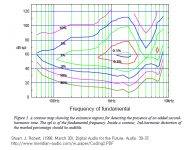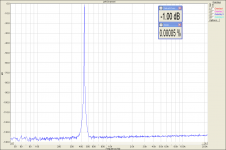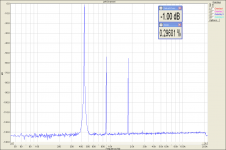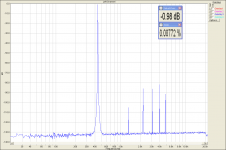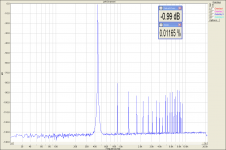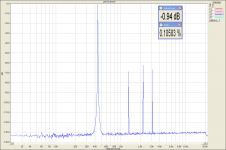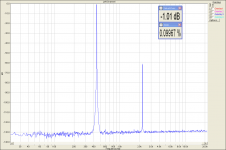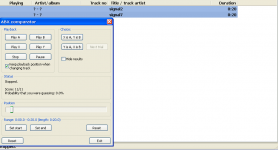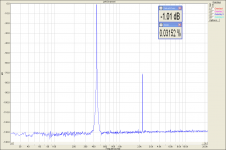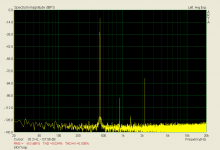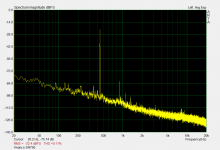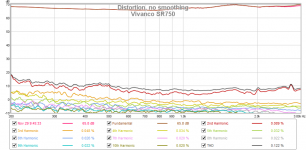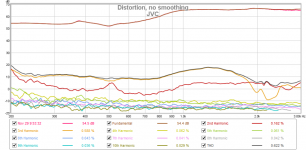Audibility of nonlinear distortions – listening test
following the discussion in “Audibility of distortion in horns!” thread, Multi-Way forum, I would like to start a new thread regarding audibility of nonlinear distortions, and to offer some files for listening tests. The tests will be performed on sine waves, as it is, IMO, the only way how to keep some control and repeatability of such tests.
Though the audibility limits of single harmonic components of distortion are quite well covered in literature, e.g. here regarding 2nd harmonic (see image attached),
https://www.meridian-audio.com/w_paper/Coding2.PDF
audibility limits of more complex distortion profiles were not usually published, AFAIK.
I have prepared 5 signals for the test. They can be downloaded from my web page:
http://pmacura.cz/signal1.wav
http://pmacura.cz/signal2.wav
http://pmacura.cz/signal3.wav
http://pmacura.cz/signal4.wav
http://pmacura.cz/signal5.wav
They are 20s long, each, same number of samples. One of the files is a pure, undistorted tone. I will reveal it, it is the signal2. The other signals are distorted and I will show the distortion spectra in this post and in the following post.
In case you are interested to perform the test, download the files and make ABX with foobar plug-in and find which files have audible distortions for you in the ABX test. Try both headphones and speakers. I was able to detect 2 files of those as having audible difference, in ABX, against the pure signal2. Both with headphones and speaker. My listening level, with speaker, was about 65dB SPL.
following the discussion in “Audibility of distortion in horns!” thread, Multi-Way forum, I would like to start a new thread regarding audibility of nonlinear distortions, and to offer some files for listening tests. The tests will be performed on sine waves, as it is, IMO, the only way how to keep some control and repeatability of such tests.
Though the audibility limits of single harmonic components of distortion are quite well covered in literature, e.g. here regarding 2nd harmonic (see image attached),
https://www.meridian-audio.com/w_paper/Coding2.PDF
audibility limits of more complex distortion profiles were not usually published, AFAIK.
I have prepared 5 signals for the test. They can be downloaded from my web page:
http://pmacura.cz/signal1.wav
http://pmacura.cz/signal2.wav
http://pmacura.cz/signal3.wav
http://pmacura.cz/signal4.wav
http://pmacura.cz/signal5.wav
They are 20s long, each, same number of samples. One of the files is a pure, undistorted tone. I will reveal it, it is the signal2. The other signals are distorted and I will show the distortion spectra in this post and in the following post.
In case you are interested to perform the test, download the files and make ABX with foobar plug-in and find which files have audible distortions for you in the ABX test. Try both headphones and speakers. I was able to detect 2 files of those as having audible difference, in ABX, against the pure signal2. Both with headphones and speaker. My listening level, with speaker, was about 65dB SPL.
Attachments
Attachments
One issue is that the audibility of distortion at ~60dB using a "pure" sine wave I think has been already shown to be poor. Still I am interested in the idea. Of course for the test to have legitimate or meaningful results there would of necessity be no confounding factors and no masking effects (regardless of their source or nature).
Of course in listening one is "stacking" the sums and differences (if there is a diff produced) of the signal + the electronics + the speaker + the ambient sounds + air.
My expectation is that some % may be able to identify differences that are essentially "invisible" to a much larger %... and also it has been shown that fairly large amounts of spectra of one type are not particularly audible while rather small amounts of spectra of another are quite audible. Seems like the GedLee Metric points at this, as did D.E.L. Shorter's work many decades before.
Looking forward to seeing what is wrung out!
_-_-
Of course in listening one is "stacking" the sums and differences (if there is a diff produced) of the signal + the electronics + the speaker + the ambient sounds + air.
My expectation is that some % may be able to identify differences that are essentially "invisible" to a much larger %... and also it has been shown that fairly large amounts of spectra of one type are not particularly audible while rather small amounts of spectra of another are quite audible. Seems like the GedLee Metric points at this, as did D.E.L. Shorter's work many decades before.
Looking forward to seeing what is wrung out!
_-_-
plug in troubles, file format troubles, can't listen
Do not use plug-ins to listen directly. Right click on the link and store the file. It is a standard, 44.1kHz, 16-bit PCM wav. Then use foobar to listen, and foobar ABX plug-in.
Of course in listening one is "stacking" the sums and differences (if there is a diff produced) of the signal + the electronics + the speaker + the ambient sounds + air.
Yes, for this reason I always check the whole electrical signal loop to check distortions.
I can say that my limit, still detectable in ABX, is 0.03% of 5th harmonic distortion. With headphones and a lot of concentration, and "proper" volume. With speakers, I would not be able to detect this.
Attachments
Last edited:
Great test Pavel 
I've listened to these via headphones at modest level and haven't looked at any spectra or studied any of the other posts. I didn't use Foobar, I simply played each in Media Player and carried the result in audible memory.
The only info I have carried is from post #1 and that Signal 2 is the pure tone.
Signal 2, 3 and 4 sound similar.
Signal 1, 5 and Signal 6 have fairly similar subjective amplitude of extra harmonics with the harmonic of Signal 5 appearing higher in frequency.
Comparing Signal 7 to Signal 2 shows that 7 has a very faint audible harmonic. I can't determine whether the frequency of that harmonic matches any of the others subjectively although on another listen I think it matches most closely that of Signal 5.

I've listened to these via headphones at modest level and haven't looked at any spectra or studied any of the other posts. I didn't use Foobar, I simply played each in Media Player and carried the result in audible memory.
The only info I have carried is from post #1 and that Signal 2 is the pure tone.
Signal 2, 3 and 4 sound similar.
Signal 1, 5 and Signal 6 have fairly similar subjective amplitude of extra harmonics with the harmonic of Signal 5 appearing higher in frequency.
Comparing Signal 7 to Signal 2 shows that 7 has a very faint audible harmonic. I can't determine whether the frequency of that harmonic matches any of the others subjectively although on another listen I think it matches most closely that of Signal 5.
LOL. Yes, that worked. 
Listening from laptop built in soundcard and headphones, only 5 and 7 really stand out for me. Detectable, for sure. #3 could have a bit of something in it, but hard to tell. I can't even describe what I hear, it's just "something". Will try a better soundcard and Foobar ABX.
Listening from laptop built in soundcard and headphones, only 5 and 7 really stand out for me. Detectable, for sure. #3 could have a bit of something in it, but hard to tell. I can't even describe what I hear, it's just "something". Will try a better soundcard and Foobar ABX.
with tube amp which already makes distortion:
1. lower of higher pitch sounding distortion sound, obvious
2. cleaner but still distortion (maybe my amp?)
3. hard to tell if different from #2.
4. can't hear much distortion, still sounds different
5. high pitch distortion, obvious
6. overtone, obvious
7. faint distortion, & the signal sounds weird
1. lower of higher pitch sounding distortion sound, obvious
2. cleaner but still distortion (maybe my amp?)
3. hard to tell if different from #2.
4. can't hear much distortion, still sounds different
5. high pitch distortion, obvious
6. overtone, obvious
7. faint distortion, & the signal sounds weird
Last edited:
With headphones and a lot of concentration, and "proper" volume.
Which headphones did you use? Innerfidelity's measurements rarely shows one that can approach 0.1%, which suggests higher sensitivity to NLD than even you achieved.
The Vivanco appears well up to the task of not masking the fifth. Interesting experiment.
Second order cancellation is easy to demonstrate with electronics, I always wondered if the same mechanism occurs between electronics and transducers and could never see why it wouldn't in some cases. If so injecting second at the source would actually reduce the acoustic level at the ear until a threshold is reached and it starts increasing again, giving an optimistic estimate of inaudibility.
Second order cancellation is easy to demonstrate with electronics, I always wondered if the same mechanism occurs between electronics and transducers and could never see why it wouldn't in some cases. If so injecting second at the source would actually reduce the acoustic level at the ear until a threshold is reached and it starts increasing again, giving an optimistic estimate of inaudibility.
We can try now what is the audible effect of nonlinear distortion on 1/3 octave noise. The files (monophonic) are here:
http://pmacura.cz/noise3rdoct.zip
In both cases harmonic distortion is about 0.6%. We can see that 2nd harmonic distortion creates a huge intermodulation product in the low frequency band. It has the same width (270 Hz) as the 1/3 octave noise. Then we can see harmonic distortion.
The 3rd harmonic creates intermodulation as well, at can be seen as a broadening of the frequency in the lower half of amplitudes. Harmonic distortion can be seen as well.
Both 2nd harmonic and 3rd harmonic distortion of 1/3 octave noise provided should be easily audible for you in the ABX test, with 100% success.
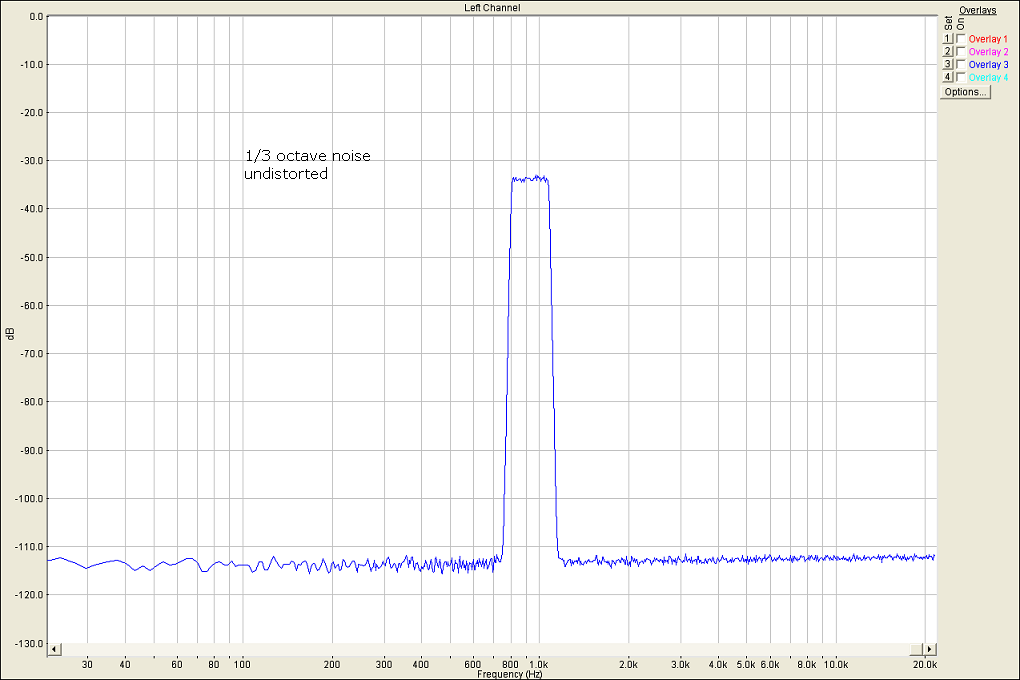
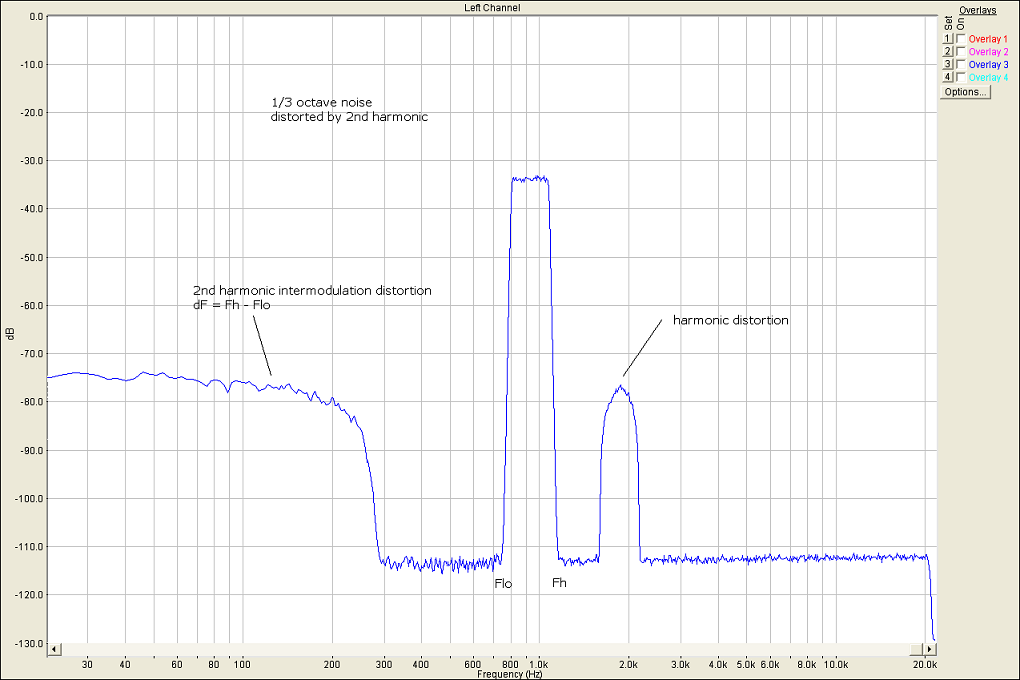
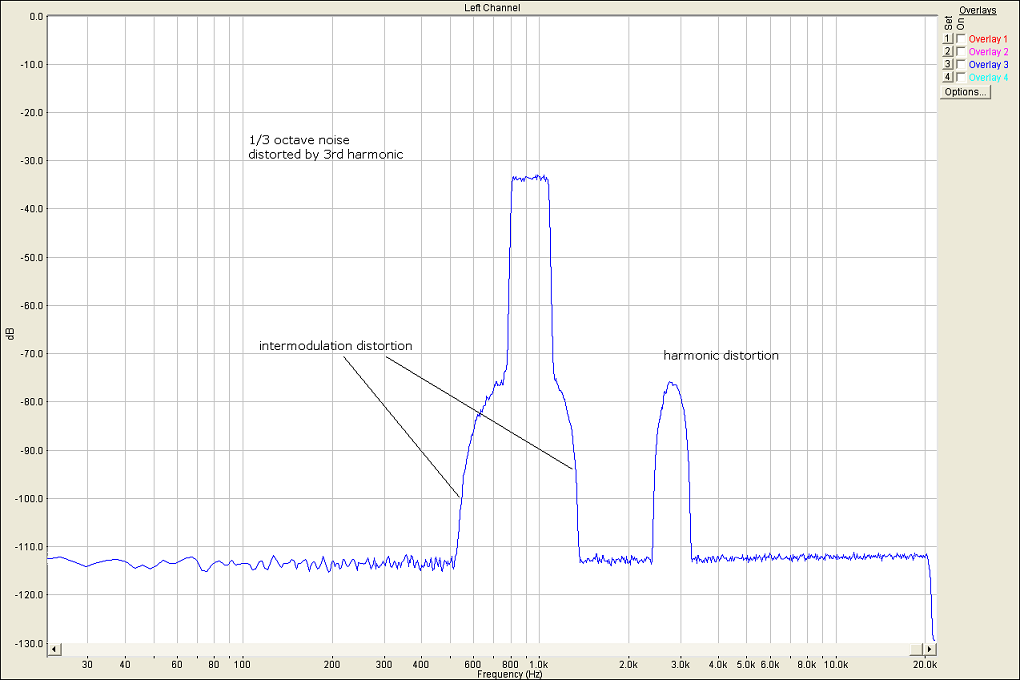
http://pmacura.cz/noise3rdoct.zip
In both cases harmonic distortion is about 0.6%. We can see that 2nd harmonic distortion creates a huge intermodulation product in the low frequency band. It has the same width (270 Hz) as the 1/3 octave noise. Then we can see harmonic distortion.
The 3rd harmonic creates intermodulation as well, at can be seen as a broadening of the frequency in the lower half of amplitudes. Harmonic distortion can be seen as well.
Both 2nd harmonic and 3rd harmonic distortion of 1/3 octave noise provided should be easily audible for you in the ABX test, with 100% success.



- Status
- This old topic is closed. If you want to reopen this topic, contact a moderator using the "Report Post" button.
- Home
- General Interest
- Everything Else
- Audibility of nonlinear distortion - new listening test
